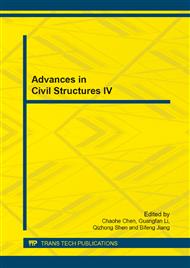p.509
p.517
p.523
p.527
p.532
p.536
p.540
p.546
p.550
A Shape Optimization Based on Strain Energy for Framed Structures
Abstract:
A shape optimization method based on strain energy is proposed for framed structures. This method combines free nodal shift, or restricted nodal shift on a specified line in the structural geometry. The optimization is based on nodal sensitivity information to amend the structural shape to achieve a structure with minimum strain energy. In this method, the design parameters, such as initial structure, supporting conditions, spatial constraints, etc, have significant influence on the final structural form; so various structural forms can be obtained by changing these design parameters in the project design phase. A numerical example is provided to illustrate the validity of this method and the mechanical behaviour of the structure. Results show that this can effectively reduce the structural bending moments and ensure sufficient structural stiffness.
Info:
Periodical:
Pages:
532-535
Citation:
Online since:
July 2014
Authors:
Keywords:
Price:
Сopyright:
© 2014 Trans Tech Publications Ltd. All Rights Reserved
Share:
Citation:


